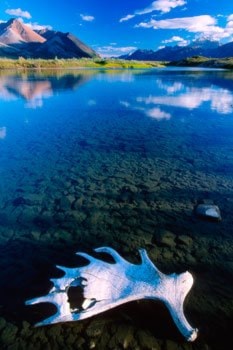Energy Mines and Resources is keeping its eyes on the winter road, not future uranium mining in the Wind River watershed.
The department is considering the Yukon Environmental and Socio-economic Assessment Board’s review of a plan to expand uranium exploration infrastructure in a region considered one of North America’s last wildernesses.
Vancouver-based Cash Minerals plans to build 178 kilometres of winter road, spur roads and an airstrip to increase uranium exploration activity in the area.
The assessment board approved the proposal on December 24. It attached 46 conditions that must be met by the company to lessen impacts on wildlife, land and tourism, all of which could be affected by the development.
Critics noted how the expansion enables future uranium mining in the 32,000-square-kilometre Wind River region in Northeast Yukon.
The assessment board disregarded those concerns because they lay outside its mandate.
Instead, it focused solely on the road proposal, not future mining possibilities.
The Yukon government’s lands branch has until January 22 to accept, decline or modify the review and its recommendations.
But the department has no plans to consider future uranium mining in its review.
“Some folks in minerals may be looking at the possibility of (Cash Minerals) coming forward in the future to make a mining application, but that would involve the federal government and a whole new process,” said Energy, Mines spokesperson Ron Billingham.
“What we’re looking at is a land user making application to use a winter trail. That’s what the recommendation deals with, that’s what the application focused on and that’s what the conditions apply to.”
Plans to mine for uranium, a federally regulated activity, would trigger another review by the assessment board.
“This would go through a much, much deeper application process,” said Billingham.
The road project “will have significant adverse environmental or socio-economic effects,” according to the 35-page review by the assessment board’s Mayo office.
Despite the opinion that the road, airstrip, and fuel and supply caches could harm tourism, trapping, land and animal habitat, the plan was approved pending Cash Minerals’ following 46 requirements laid out in the review.
Many of the conditions push for information sharing and reporting by Cash Minerals about travel, environmental operations and wildlife spottings.
Cash Minerals wants to double the number of cache sites to eight, from the four it uses now.
The drill program has minimal impact, said the review.
The area has been explored and drilled since 1930, but is still used by tour guides offering clients a pristine wildlife experience.
Caribou, moose, sheep, grizzly and black bears, wolves, coyotes, hares, lynx, fox and other furbearers roam the region.
Bird species include ptarmigan, grouse, eagles, and various migratory waterfowl.
The Peel Watershed Planning Commission is currently drafting a land-use plan for the area. It requested the project be delayed pending completion of the plan, slated for late 2008.
Proceeding before the plan is finished compromises the commission’s work, said Albert Genier, its chair.
“The commission’s work can be hampered when development activities occur concurrently to the planning process,” he said in a letter to the assessment board.
“An individual project can … introduce an activity that may not conform to the commission’s vision for the region.
“The commission believes that the development of the winter road, spur roads and airstrip potentially have far-reaching implications to the long-term character of the Peel watershed.”
The commission is not a lobby group, said David Loeks, a boardmember. He would not comment on the assessment board’s recommendations.
The commission will continue working on its land-use plan, he added.
The government will not be considering the land-use plan in its review of the assessment board’s recommendations.
“We can’t put everything on hold to wait for land-use planning, that goes for all industry whether it’s tourism, mineral explorations or outfitting,” said Billingham.
“We have to be able to do concurrent activities — moving forward with industry — in spite of and in concert with land-use planning.
“Industry will be allowed to operate while land-use plans are being finalized.”
Several government departments, including Tourism and Culture, Economic Development and Environment, will be reviewing the 46 recommendations.
